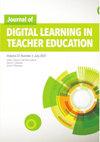Computational Thinking: What Went Wrong?
Q1 Social Sciences
Journal of Digital Learning in Teacher Education
Pub Date : 2020-01-02
DOI:10.1080/21532974.2019.1696641
引用次数: 2
Abstract
The recent focus upon Computational Thinking and suggestions that Computational Thinking (CT) should be included in preK-12 education as well as teacher education brings back memories of earlier times in the area of technology in teacher education. Looking back at the history of our field, some of us remember an early (1980’s) emphasis on CT. Although most did not call it CT at the time, many of the early leaders and followers in the Logo movement were interested and inspired by the possibilities of the computer as “an object to think with” and an environment where children could learn important problem solving skills in an active, student centered way. As Glen Bull, Joe Garfalo, and Rich Nguyen mention in their article in this issue: “Thinking About Computational Thinking: Origins of Computational Thinking in Educational Computing,” Seymour Papert provided a clear vision for using technology to provide problem solving environments where children could develop skills that we now call CT. Papert’s visions for technology use in schools were clearly articulated in Mindstorms (1980) and these visions motivated many of us to begin to define and explore uses of computers in classrooms. Much of this early work involved designing environments for using the Logo language in classrooms. More than 40 years have passed since this early work with Logo and much of the early enthusiasm for Logo as a tool for classroom teachers waned after the initial excitement over Papert’s vision. In fact, younger researchers and educators may view the current emphasis on CT as a new area of emphasis for technology in teacher education rather than the reemergence of a significant piece of our history. Honoring, understanding and using the history of Logo and Papert’s visions for computer use in classrooms needs to be an important part of the current work in CT and the “Thinking about Computational Thinking” article in this issue should be a required read for those working on CT research and development today. Forty years ago Papert presented a clear vision of the importance of CT in schools and specific ideas for how to incorporate CT in classrooms. After initial enthusiasm for Papert’s approach, however, classroom use of computers turned toward using computers to augment and enhance existing curriculum and methods. It is important to understand what happened to the early efforts to incorporate CT in schools and the use of the computer as “an object to think with.” Looking back, we suggest there are four major reasons that our initial uses of computers in schools focused upon integrating computers into existing curriculum and methods and not on creating environments for learning CT.计算思维:出了什么问题?
最近对计算思维的关注,以及计算思维(CT)应该被纳入学前教育和教师教育的建议,让人回想起早期教师教育中的技术领域。回顾我们领域的历史,我们中的一些人记得早期(20世纪80年代)对CT的重视。尽管当时大多数人并不把它称为计算机计算机,但许多早期的领导者和追随者对计算机作为“思考对象”的可能性很感兴趣,并受到启发,因为计算机是一个环境,孩子们可以以积极的、以学生为中心的方式学习重要的解决问题的技能。正如Glen Bull、Joe Garfalo和Rich Nguyen在本期的文章《关于计算思维的思考:教育计算中计算思维的起源》中提到的那样,Seymour Papert提供了一个清晰的愿景,即利用技术提供解决问题的环境,让孩子们发展我们现在称之为CT的技能。Papert在《头脑风暴》(Mindstorms, 1980)一书中明确阐述了技术在学校中的应用,这些设想促使我们中的许多人开始定义和探索计算机在教室中的应用。早期的大部分工作涉及设计在教室中使用Logo语言的环境。与Logo的早期合作已经过去了40多年,最初对Papert愿景的兴奋之后,人们对Logo作为课堂教师工具的热情逐渐消退。事实上,年轻的研究人员和教育工作者可能会把当前对CT的强调看作是教师教育中技术的一个新领域,而不是我们历史上一个重要部分的重新出现。尊重、理解和使用Logo和Papert在教室中使用计算机的愿景的历史需要成为当前CT工作的重要组成部分,本期的“关于计算思维的思考”文章应该是当今从事CT研究和开发的人的必读文章。四十年前,佩珀特就CT在学校的重要性提出了清晰的愿景,并就如何将CT纳入课堂提出了具体的想法。然而,在最初对Papert的方法充满热情之后,计算机的课堂使用转向使用计算机来增加和增强现有的课程和方法。重要的是要了解早期将CT纳入学校和将计算机作为“思考对象”使用的努力发生了什么。回顾过去,我们认为我们最初在学校使用计算机的主要原因是将计算机集成到现有的课程和方法中,而不是为学习CT创造环境。
本文章由计算机程序翻译,如有差异,请以英文原文为准。
求助全文
约1分钟内获得全文
求助全文
来源期刊

Journal of Digital Learning in Teacher Education
Social Sciences-Education
CiteScore
4.90
自引率
0.00%
发文量
15
 求助内容:
求助内容: 应助结果提醒方式:
应助结果提醒方式:


